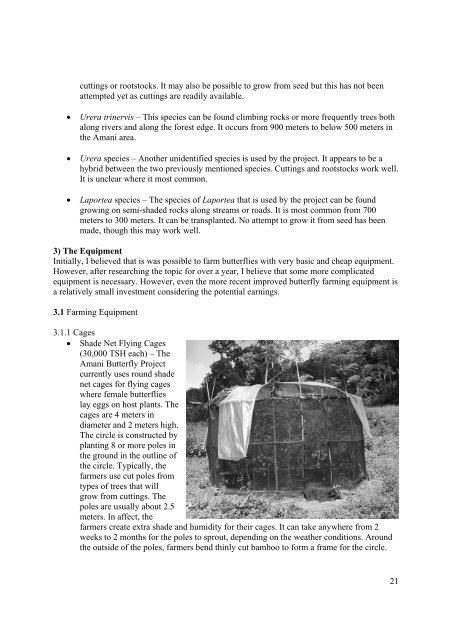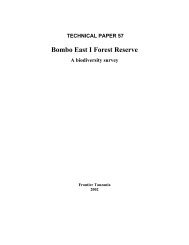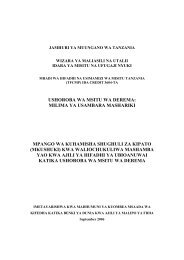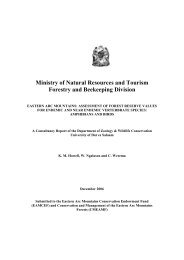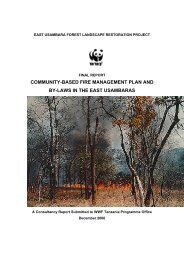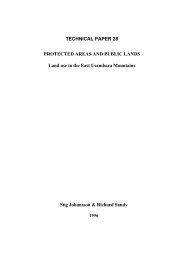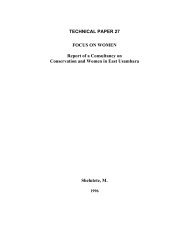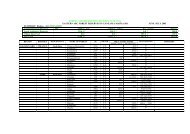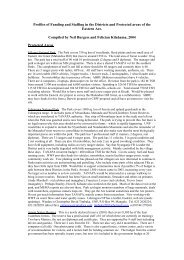Butterfly Farming in the East Usambara Mountains - Eastern Arc ...
Butterfly Farming in the East Usambara Mountains - Eastern Arc ...
Butterfly Farming in the East Usambara Mountains - Eastern Arc ...
You also want an ePaper? Increase the reach of your titles
YUMPU automatically turns print PDFs into web optimized ePapers that Google loves.
cutt<strong>in</strong>gs or rootstocks. It may also be possible to grow from seed but this has not been<br />
attempted yet as cutt<strong>in</strong>gs are readily available.<br />
• Urera tr<strong>in</strong>ervis – This species can be found climb<strong>in</strong>g rocks or more frequently trees both<br />
along rivers and along <strong>the</strong> forest edge. It occurs from 900 meters to below 500 meters <strong>in</strong><br />
<strong>the</strong> Amani area.<br />
• Urera species – Ano<strong>the</strong>r unidentified species is used by <strong>the</strong> project. It appears to be a<br />
hybrid between <strong>the</strong> two previously mentioned species. Cutt<strong>in</strong>gs and rootstocks work well.<br />
It is unclear where it most common.<br />
• Laportea species – The species of Laportea that is used by <strong>the</strong> project can be found<br />
grow<strong>in</strong>g on semi-shaded rocks along streams or roads. It is most common from 700<br />
meters to 300 meters. It can be transplanted. No attempt to grow it from seed has been<br />
made, though this may work well.<br />
3) The Equipment<br />
Initially, I believed that is was possible to farm butterflies with very basic and cheap equipment.<br />
However, after research<strong>in</strong>g <strong>the</strong> topic for over a year, I believe that some more complicated<br />
equipment is necessary. However, even <strong>the</strong> more recent improved butterfly farm<strong>in</strong>g equipment is<br />
a relatively small <strong>in</strong>vestment consider<strong>in</strong>g <strong>the</strong> potential earn<strong>in</strong>gs.<br />
3.1 <strong>Farm<strong>in</strong>g</strong> Equipment<br />
3.1.1 Cages<br />
• Shade Net Fly<strong>in</strong>g Cages<br />
(30,000 TSH each) – The<br />
Amani <strong>Butterfly</strong> Project<br />
currently uses round shade<br />
net cages for fly<strong>in</strong>g cages<br />
where female butterflies<br />
lay eggs on host plants. The<br />
cages are 4 meters <strong>in</strong><br />
diameter and 2 meters high.<br />
The circle is constructed by<br />
plant<strong>in</strong>g 8 or more poles <strong>in</strong><br />
<strong>the</strong> ground <strong>in</strong> <strong>the</strong> outl<strong>in</strong>e of<br />
<strong>the</strong> circle. Typically, <strong>the</strong><br />
farmers use cut poles from<br />
types of trees that will<br />
grow from cutt<strong>in</strong>gs. The<br />
poles are usually about 2.5<br />
meters. In affect, <strong>the</strong><br />
farmers create extra shade and humidity for <strong>the</strong>ir cages. It can take anywhere from 2<br />
weeks to 2 months for <strong>the</strong> poles to sprout, depend<strong>in</strong>g on <strong>the</strong> wea<strong>the</strong>r conditions. Around<br />
<strong>the</strong> outside of <strong>the</strong> poles, farmers bend th<strong>in</strong>ly cut bamboo to form a frame for <strong>the</strong> circle.<br />
21


